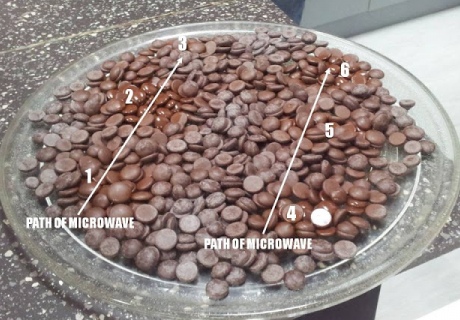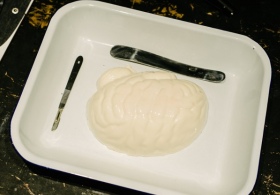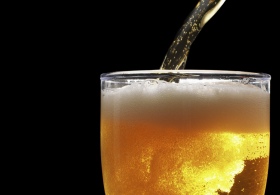
Chris Clarke at an Imperial Fringe event

Chocolate melting in a microwave, the froth on a pint of beer and brain-shaped jelly can all teach us something about science.
Food and drink are part of our everyday lives and now they are tantalising the taste-buds of science communicators. With over 35 UK science outreach events dedicated to science and food since 2012, science communication student Chris Clarke explains why science is becoming so palatable.
Science communication has come a long way in recent decades and not just in terms of celebrity scientists edging into the media spotlight. In their search for a two-way dialogue, scientists and science communicators are increasingly putting the chalk and duster to one side and searching for new ways to interact.
Gastronomy-science can turn a kitchen into a laboratory and a meal into an experiment.
– Chris Clarke
science communciation student
While studying science communication at Imperial, I explored food and drink-themed events and interviewed a selection of chefs and science communicators. My research suggests that food is a naturally efficient medium for communication. Its varied physical and chemical compositions make it useful for demonstrating a huge variety of scientific principles and its social relevance makes it familiar and accessible to all.
I spoke to Professor Peter Barham at the University of Bristol, one of the founding fathers of ‘Molecular Gastronomy’, to determine why he thinks gastronomy could be the key to science communication.
“Anybody who is a practicing scientist can relate their research to food if they think about it,” he explained. “All you do is you put your own spin on it. The food is the medium, is the vehicle. Things happen and change when you play with food so it depends on what you want to emphasise.”
The numerous events I visited certainly bore testament to Barham’s words. From the public dissection of jelly brains by neuroscientists, to the formation of bubbles in pint glasses for the perfect beer head, there was truly something for everyone.
Melting chocolate
Why use the microwave to reheat last night’s leftovers when you can be measuring the speed of light? That was the question asked by Dr Simon Foster when demonstrating this well-known experiment at the Imperial Fringe last December.

In this kitchen experiment the microwave’s turntable is removed and replaced with a layer of chocolate chips or thinly sliced cheese. When the microwave is turned on, the radiation forms a fixed pattern of waves that are held between the internal walls, like a string on a guitar that has just been plucked. After a few seconds these peaks will be visible as patches of melted chocolate or cheese. By measuring the distance between the melted patches you can determine the wavelength of the microwaves. From here it is short work to identify the microwave frequency (labelled on the appliance), and multiply this with the measured wavelength. What you get should be a reasonable value for the speed of light.
Jelly brain
 One popular demonstration, by the festival science group Guerilla Science, is the ‘Jelly Brain Dissection’, which has found its way to various events in recent years. A wobbly gelatin-based model of the human brain is laid out before a rapt audience, then an experienced neuroscientist or neurosurgeon arrives to begin the dissection. With scalpel in hand the surgeon carefully carves out various sections of the brain while discussing its known functions and impacts on how we act and perceive the world around us. Jen Wong, Director of Guerilla Science, believes it’s a completely different way to approach the subject.
One popular demonstration, by the festival science group Guerilla Science, is the ‘Jelly Brain Dissection’, which has found its way to various events in recent years. A wobbly gelatin-based model of the human brain is laid out before a rapt audience, then an experienced neuroscientist or neurosurgeon arrives to begin the dissection. With scalpel in hand the surgeon carefully carves out various sections of the brain while discussing its known functions and impacts on how we act and perceive the world around us. Jen Wong, Director of Guerilla Science, believes it’s a completely different way to approach the subject.
“It’s really communicating the functional anatomy of the brain but in quite a sensory way.”
Perhaps a part for the more strong stomached; each segment of the dissection is followed by the serving of the relevant brain section to the audience.
Beer head
 What makes a good or bad beer? For some people it’s price, for some it’s flavour, but what most people don’t know is that a lot of it is in the serving. Dr Sujata Kundu of Imperial College London enjoys her drinks demonstrations and if there’s beer involved then even better. To take lager as an example, one of its great features is the nice frothy head and continuous fizz, but Dr Kundu points out that if you don’t have the right glass then you may as well stick with bitter. In order to have a respectable number of bubbles in your pint, the bubbles require places to form known as ‘nucleation sites’, which can be as simple as small scratches in the glass. In most lager glasses now you’ll notice a pattern scratched into the base to ensure a steady stream of bubbles throughout your drink.
What makes a good or bad beer? For some people it’s price, for some it’s flavour, but what most people don’t know is that a lot of it is in the serving. Dr Sujata Kundu of Imperial College London enjoys her drinks demonstrations and if there’s beer involved then even better. To take lager as an example, one of its great features is the nice frothy head and continuous fizz, but Dr Kundu points out that if you don’t have the right glass then you may as well stick with bitter. In order to have a respectable number of bubbles in your pint, the bubbles require places to form known as ‘nucleation sites’, which can be as simple as small scratches in the glass. In most lager glasses now you’ll notice a pattern scratched into the base to ensure a steady stream of bubbles throughout your drink.
“It’s such a basic thing, it’s just a nucleation point and somewhere for the bubbles to form and then they float up and then they can, if you’re lucky, make a pattern,” said Dr Kundu.
In her workshops Dr Kundu has volunteers test this by scratching simple patterns into the base of glasses. If all goes well the heads that form after pouring should mimic their etched shapes.
The beauty of food and drink, it seems, is that it is not just a popularity stunt; the fact that an audience can eat the demonstration material is a happy coincidence. Gastronomy-science can turn a kitchen into a laboratory and a meal into an experiment. With just a small amount of extra knowledge gastronomy really could prove the ultimate means for effective science communication.
Article text (excluding photos or graphics) available under an Attribution-NonCommercial-ShareAlike Creative Commons license.
Photos and graphics subject to third party copyright used with permission or © Imperial College London.
Reporter
Christopher Clarke
Department of Humanities

Contact details
Email: press.office@imperial.ac.uk
Show all stories by this author




Leave a comment
Your comment may be published, displaying your name as you provide it, unless you request otherwise. Your contact details will never be published.